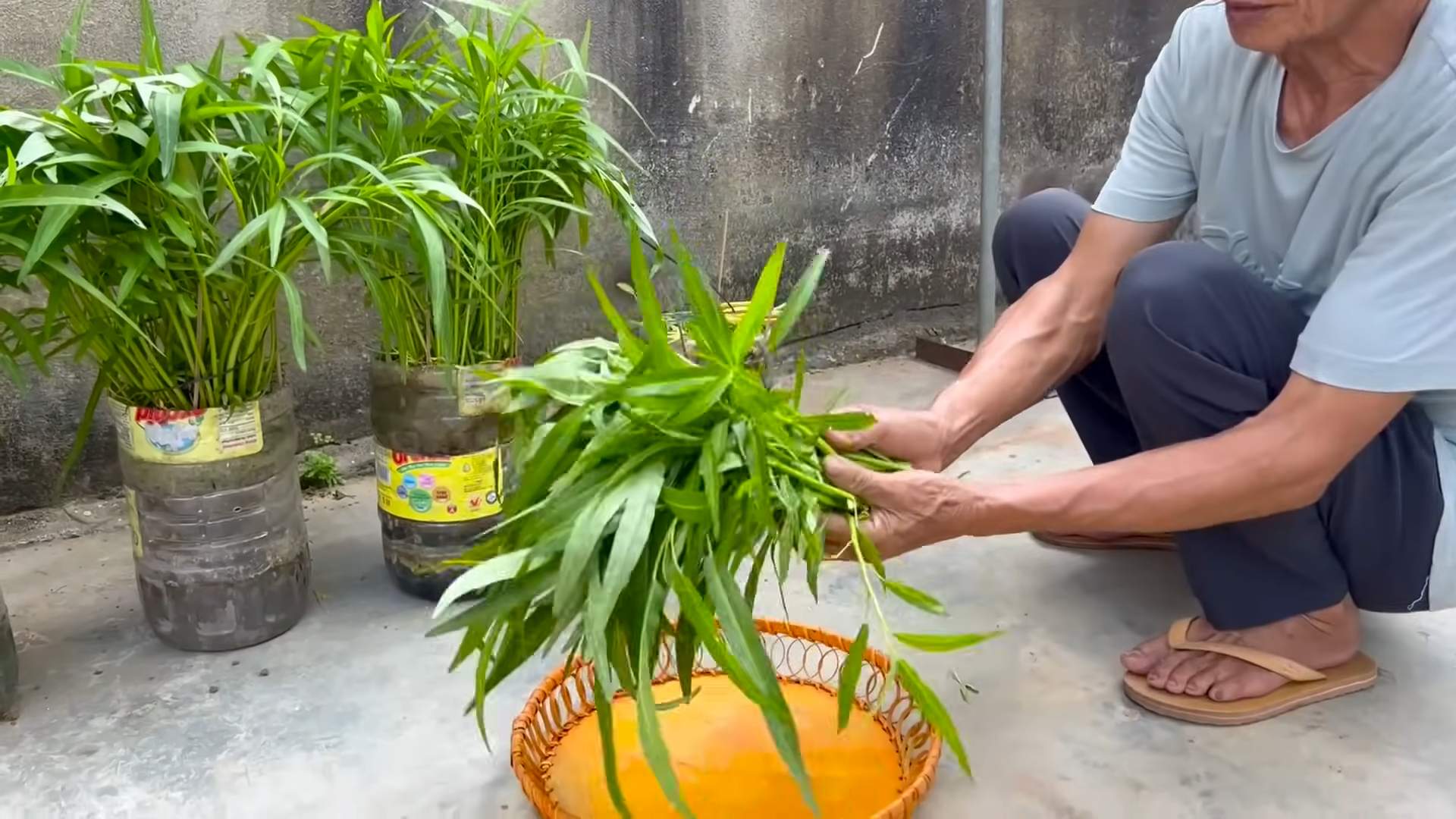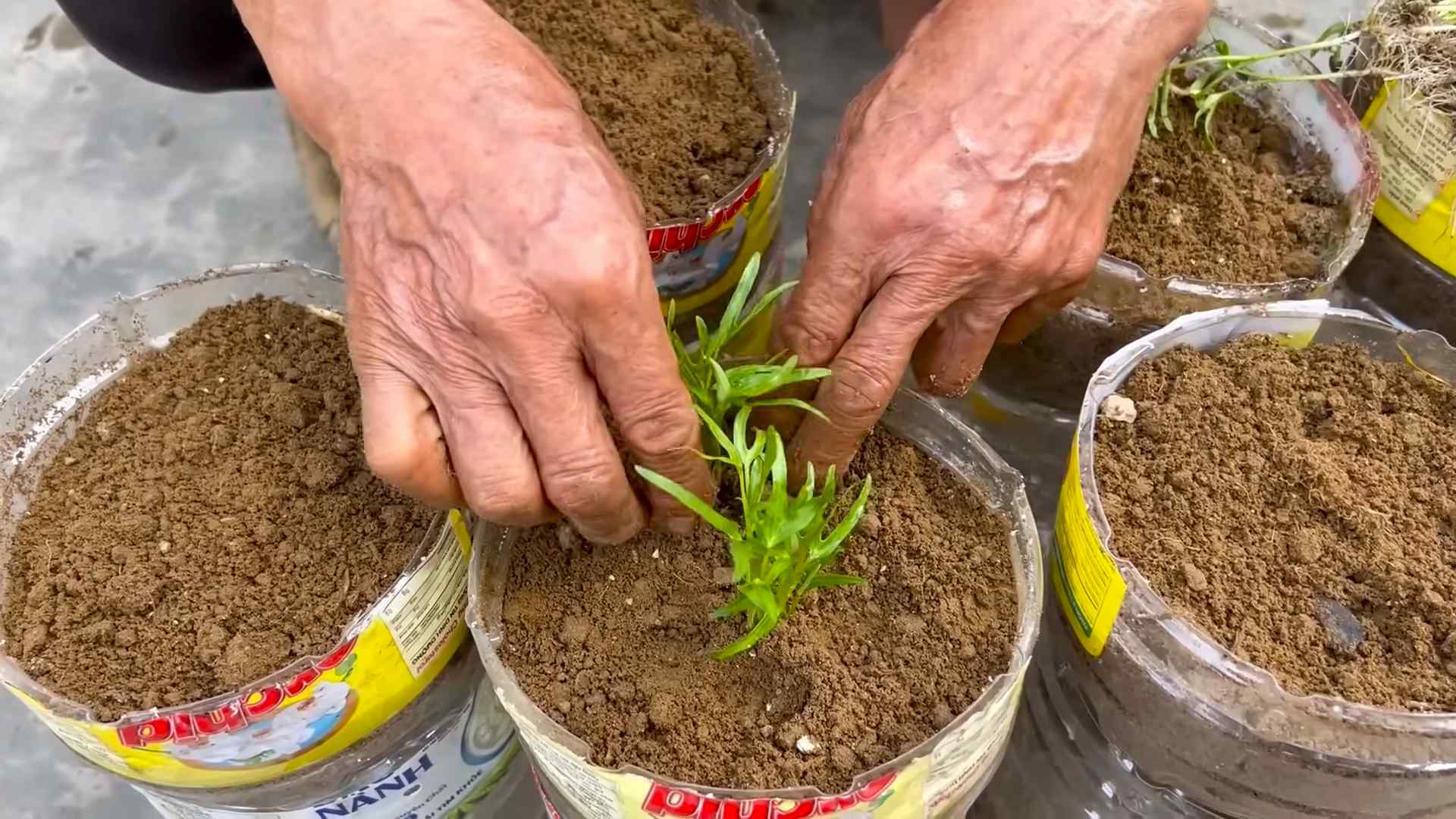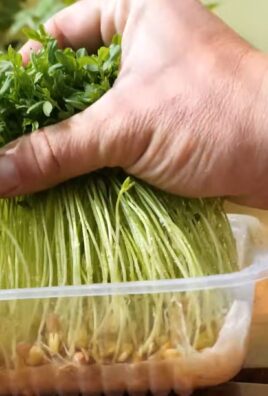Growing Water Spinach at home might sound intimidating, but trust me, it’s easier than you think! Have you ever dreamed of snipping fresh, vibrant greens right from your own backyard to add to your stir-fries or soups? Well, dream no more! This DIY guide will unlock the secrets to cultivating this delicious and nutritious leafy vegetable, even if you’re a complete beginner.
Water spinach, also known as Ong Choy or Kangkong, has a rich history, deeply rooted in Southeast Asian cuisine. For centuries, it’s been a staple in dishes across the region, prized for its mild flavor and impressive nutritional benefits. It’s packed with vitamins, minerals, and antioxidants, making it a healthy and delicious addition to any meal.
But why should you bother growing water spinach yourself? Simple! Store-bought water spinach can sometimes be hard to find, and when you do find it, it might not be as fresh as you’d like. Plus, growing your own allows you to control exactly what goes into your food, ensuring it’s free from harmful pesticides and chemicals. In this article, I’ll share my favorite DIY tricks and hacks to help you successfully cultivate this amazing vegetable, transforming your garden (or even just a sunny windowsill!) into a thriving source of fresh, healthy greens. Get ready to get your hands dirty and enjoy the satisfaction of harvesting your very own water spinach!

Growing Water Spinach (Kangkong) at Home: A DIY Guide
Hey there, fellow gardening enthusiasts! I’m so excited to share my experience with growing water spinach, also known as kangkong or ong choy, right in my own backyard. It’s surprisingly easy, incredibly rewarding, and you get a constant supply of fresh, delicious greens. Plus, it’s a fantastic way to add some vibrant color to your garden. Let’s dive in!
What You’ll Need
Before we get started, let’s gather all the necessary supplies. Trust me, having everything ready beforehand will make the whole process much smoother.
* Water Spinach Seeds or Cuttings: You can find these at most Asian grocery stores or online. I personally prefer seeds for starting out, but cuttings work great too!
* A Large Container or Tub: Think big! Water spinach loves space. A plastic tub, a large pot, or even a repurposed kiddie pool will do the trick. Aim for something at least 12 inches deep.
* Potting Soil: A good quality potting mix is essential. You can also amend it with compost for extra nutrients.
* Water: Obviously! You’ll need a consistent supply of water, as water spinach thrives in moist conditions.
* Sunlight: Water spinach needs at least 6 hours of direct sunlight per day. Choose a sunny spot in your garden or balcony.
* Optional: Fertilizer: A balanced liquid fertilizer can help boost growth, but it’s not strictly necessary.
* Gardening Gloves: To keep your hands clean and protected.
* Watering Can or Hose: For easy watering.
* Scissors or Pruning Shears: For harvesting.
Choosing Your Growing Method: Seeds vs. Cuttings
You have two main options for starting your water spinach: from seeds or from cuttings. Both methods are relatively straightforward, but they have their own pros and cons.
* Seeds: Starting from seeds takes a bit longer, but it’s a great way to ensure you have healthy, vigorous plants. Plus, it’s super satisfying to watch them sprout and grow!
* Cuttings: Using cuttings is faster and easier, especially if you already have access to water spinach. Simply take a cutting from an existing plant and root it in water or directly in soil.
I’ll cover both methods in detail below.
Growing Water Spinach from Seeds
This is my preferred method, as I love watching the seeds germinate and grow into lush plants.
1. Soaking the Seeds: Before planting, soak the water spinach seeds in warm water for 12-24 hours. This helps to soften the seed coat and improve germination rates. I usually put them in a small bowl and leave them on the counter overnight.
2. Preparing the Container: Fill your container with potting soil, leaving about an inch or two of space at the top. Water the soil thoroughly until it’s evenly moist but not waterlogged.
3. Sowing the Seeds: Sprinkle the soaked seeds evenly over the surface of the soil. You don’t need to bury them too deep; just gently press them into the soil with your fingers. A depth of about ¼ inch is perfect.
4. Covering the Seeds: Lightly cover the seeds with a thin layer of soil or vermiculite. This helps to retain moisture and protect the seeds from drying out.
5. Watering Gently: Water the soil gently using a watering can or a spray bottle. Be careful not to dislodge the seeds.
6. Creating a Humid Environment: To create a humid environment, you can cover the container with a clear plastic bag or a plastic wrap. This will help to keep the soil moist and promote germination. Make sure to poke a few holes in the plastic for ventilation.
7. Finding a Sunny Spot: Place the container in a warm, sunny location. Water spinach needs plenty of sunlight to thrive.
8. Waiting for Germination: Be patient! Water spinach seeds typically germinate within 7-14 days. Keep the soil consistently moist during this time.
9. Removing the Cover: Once the seedlings emerge, remove the plastic cover.
10. Thinning the Seedlings: If you have too many seedlings growing close together, thin them out to allow for better air circulation and growth. Space the seedlings about 4-6 inches apart.
Growing Water Spinach from Cuttings
This method is super convenient if you already have access to water spinach.
1. Selecting Cuttings: Choose healthy, vigorous stems from an existing water spinach plant. The cuttings should be about 6-8 inches long and have several leaves.
2. Preparing the Cuttings: Remove the lower leaves from the cuttings, leaving only the top few leaves. This will help to prevent rotting.
3. Rooting in Water (Optional): You can root the cuttings in water before planting them in soil. Simply place the cuttings in a glass of water, making sure that the lower nodes (where the leaves were removed) are submerged. Change the water every few days. Roots should start to appear within a week or two.
4. Planting the Cuttings: Fill your container with potting soil, just like you would for seeds.
5. Making Holes: Use your finger or a pencil to make holes in the soil, spaced about 4-6 inches apart.
6. Inserting the Cuttings: Gently insert the cuttings into the holes, making sure that the lower nodes are buried in the soil.
7. Watering Thoroughly: Water the soil thoroughly until it’s evenly moist.
8. Providing Support (Optional): If the cuttings are tall and wobbly, you can provide support by staking them with small sticks or bamboo skewers.
9. Maintaining Moisture: Keep the soil consistently moist, especially during the first few weeks.
Caring for Your Water Spinach
Once your water spinach plants are established, it’s time to focus on providing them with the care they need to thrive.
* Watering: Water spinach loves water, so keep the soil consistently moist. I usually water mine every day, especially during hot weather. You can even partially submerge the container in water to create a bog-like environment.
* Sunlight: Ensure your water spinach plants receive at least 6 hours of direct sunlight per day.
* Fertilizing (Optional): If you want to boost growth, you can fertilize your water spinach plants every few weeks with a balanced liquid fertilizer. Follow the instructions on the fertilizer label. I personally use a seaweed extract fertilizer, which is a great natural option.
* Pruning: Regular pruning encourages bushier growth and prevents the plants from becoming leggy. Simply pinch off the tips of the stems to promote branching.
* Pest Control: Water spinach is generally pest-resistant, but occasionally you might encounter aphids or other common garden pests. You can usually control these pests by spraying the plants with a strong stream of water or by using an insecticidal soap.
Harvesting Your Water Spinach
The best part of growing your own water spinach is, of course, the harvest! You can start harvesting your water spinach about 4-6 weeks after planting.
1. When to Harvest: Harvest your water spinach when the stems are about 6-8 inches long.
2. How to Harvest: Use scissors or pruning shears to cut the stems about 2-3 inches above the soil line. This will encourage new growth.
3. Harvesting Regularly: Harvest your water spinach regularly to encourage continuous production. The more you harvest, the more it will grow!
4. Enjoying Your Harvest: Water spinach is incredibly versatile and can be used in a variety of dishes. It’s delicious stir-fried, steamed, or added to soups and salads.
Troubleshooting
Even with the best care, you might encounter a few challenges along the way. Here are some common problems and how to address them:
* Yellowing Leaves: This could be a sign of nutrient deficiency. Try fertilizing your plants with a balanced liquid fertilizer.
* Slow Growth: This could be due to insufficient sunlight or water. Make sure your plants are getting enough of both.
* Pests: As mentioned earlier, aphids and other pests can sometimes be a problem. Use a strong stream of water or insecticidal soap to control them.
* Leggy Growth: This is usually caused by insufficient sunlight. Move your plants to a sunnier location or provide supplemental lighting.
Tips for Success
Here are a few extra tips to help you grow the best water spinach possible:
* Choose the Right Container: Make sure your container is large enough to accommodate the plants’ growth.
* Use Good Quality Soil: A good quality potting mix will provide your plants with the nutrients they need.
* Water Regularly: Water spinach loves water, so keep the soil consistently moist.
*

Conclusion
So, there you have it! Growing your own water spinach, or *kangkong*, is not only surprisingly simple but also incredibly rewarding. Imagine stepping out into your garden or even just onto your balcony and harvesting fresh, crisp greens for your next stir-fry or salad. Forget those wilted, overpriced bunches at the grocery store. With this easy DIY trick, you’ll have a constant supply of vibrant, nutritious water spinach right at your fingertips.
This method is a must-try for several reasons. First, it’s incredibly cost-effective. Once you have your initial seeds or cuttings, you can propagate new plants indefinitely, saving you money on groceries in the long run. Second, it’s environmentally friendly. You’ll be reducing your carbon footprint by growing your own food locally and avoiding the plastic packaging that often comes with store-bought produce. Third, it’s incredibly satisfying. There’s nothing quite like the feeling of nurturing a plant from seed to harvest and then enjoying the fruits (or, in this case, the vegetables) of your labor.
But the best part? This DIY trick is incredibly versatile. You can grow water spinach in a variety of containers, from small pots to large tubs, making it suitable for even the smallest of spaces. You can also experiment with different growing mediums, such as soil, water, or a combination of both. For those who want to take their water spinach cultivation to the next level, consider adding a small aquarium pump to your water container to provide extra aeration and promote faster growth. You can also try different fertilizers to see which ones yield the best results.
Don’t be afraid to experiment and find what works best for you and your growing environment.
And speaking of environment, remember that water spinach thrives in warm, sunny conditions. If you live in a cooler climate, you may need to provide supplemental lighting or grow your plants indoors. You can also extend your growing season by starting your seeds indoors a few weeks before the last frost.
We’ve covered the basics, but the real magic happens when you get your hands dirty (or wet!). We wholeheartedly encourage you to give this DIY trick a try. It’s a fun, educational, and delicious way to connect with nature and enjoy fresh, healthy food.
Once you’ve harvested your first batch of homegrown water spinach, we’d love to hear about your experience! Share your photos, tips, and tricks in the comments below. Let’s build a community of water spinach enthusiasts and learn from each other. What challenges did you face? What successes did you celebrate? What delicious recipes did you create? Your feedback will not only help other aspiring gardeners but also inspire us to continue sharing helpful tips and tricks. So, go ahead, get growing, and let us know how it goes! Remember, the key to successful *kangkong* cultivation is patience, observation, and a little bit of love. Happy gardening!
Frequently Asked Questions (FAQ)
What exactly is water spinach, and what does it taste like?
Water spinach, also known as *kangkong*, morning glory, or swamp cabbage, is a semi-aquatic leafy green vegetable commonly used in Asian cuisine. It has long, hollow stems and arrow-shaped leaves. The taste is mild and slightly sweet, similar to spinach but with a nuttier undertone. It’s often described as having a slightly earthy flavor. The texture is crisp and slightly crunchy when cooked properly.
How long does it take to grow water spinach from seed?
Generally, you can expect to harvest your first water spinach crop about 4-6 weeks after planting seeds. The exact time will depend on factors such as temperature, sunlight, and the specific variety of water spinach you’re growing. Soaking the seeds overnight before planting can help speed up germination.
Can I grow water spinach indoors?
Yes, you can absolutely grow water spinach indoors, especially if you live in a climate with cooler temperatures. To grow water spinach indoors, you’ll need a sunny location, such as a south-facing window, or supplemental grow lights. Ensure the plants receive at least 6-8 hours of light per day. You’ll also need a container that can hold water and soil or just water, depending on your preferred growing method. Remember to monitor the water level and change it regularly to prevent algae growth.
What kind of fertilizer should I use for water spinach?
Water spinach is a heavy feeder, meaning it requires a good amount of nutrients to thrive. You can use a balanced liquid fertilizer, such as a 20-20-20, diluted to half strength. Alternatively, you can use organic fertilizers like compost tea, fish emulsion, or well-rotted manure. Apply fertilizer every 2-3 weeks, following the instructions on the product label. Be careful not to over-fertilize, as this can lead to excessive leaf growth and a less flavorful crop.
How often should I water my water spinach?
Water spinach loves water, so it’s important to keep the soil consistently moist. If you’re growing it in soil, water it daily or whenever the top inch of soil feels dry to the touch. If you’re growing it hydroponically (in water), make sure the roots are always submerged in water. Change the water every few days to prevent stagnation and algae growth.
What are some common pests and diseases that affect water spinach?
Water spinach is generally resistant to pests and diseases, but it can be susceptible to aphids, spider mites, and snails. To control aphids and spider mites, you can spray the plants with insecticidal soap or neem oil. Snails can be handpicked or trapped using beer traps. In terms of diseases, water spinach can sometimes be affected by fungal infections, such as leaf spot. To prevent fungal diseases, ensure good air circulation around the plants and avoid overwatering.
How do I harvest water spinach?
You can harvest water spinach by cutting the stems about 6-8 inches from the base of the plant. This will encourage new growth and allow you to harvest multiple times from the same plant. Harvest in the morning for the best flavor and texture. After harvesting, wash the water spinach thoroughly and store it in the refrigerator for up to a week.
Can I eat water spinach raw?
While water spinach is often eaten cooked, it can also be eaten raw in salads or as a garnish. However, it’s important to wash it thoroughly to remove any dirt or contaminants. Some people may experience mild digestive discomfort from eating raw water spinach, so it’s best to start with a small amount and see how your body reacts.
Is water spinach safe for everyone to eat?
Water spinach is generally safe for most people to eat. However, it’s important to note that it can accumulate nitrates from the soil, especially if grown in heavily fertilized conditions. People with certain health conditions, such as kidney problems, may need to limit their intake of nitrate-rich vegetables. If you have any concerns, it’s best to consult with your doctor or a registered dietitian. Also, ensure the water source is clean and free from contaminants, especially if growing hydroponically.
How can I propagate water spinach from cuttings?
Propagating water spinach from cuttings is a simple and effective way to create new plants. Simply take a cutting from a mature plant, about 6-8 inches long, and remove the lower leaves. Place the cutting in a glass of water, making sure that the nodes (the points where the leaves were removed) are submerged. Roots should start to develop within a few days. Once the roots are about an inch long, you can transplant the cutting into soil or a hydroponic system.




Leave a Comment